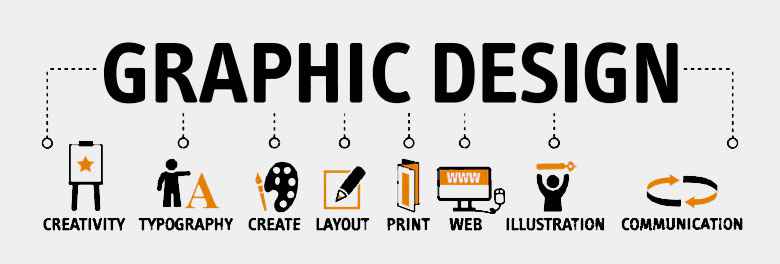Drive Engagement with Creative Graphic Design Services
Introduction of Graphic Designing
Graphic designing is the art and practice of creating visual content to communicate information and ideas to a specific audience. This can include creating images, layouts, and designs for print and digital media such as websites, advertising materials, magazines, books, packaging, logos, and more.
The goal of graphic design is to convey a message in a clear, effective, and visually appealing way. This can involve combining elements such as typography, color, images, and illustrations to create a cohesive design that captures the attention of the viewer and communicates a desired message.
Graphic designers use various tools and software to create their designs, including Adobe Photoshop, Illustrator, and InDesign, as well as traditional art materials such as pens, pencils, and markers.
Effective graphic design can have a significant impact on businesses and organizations by helping them to stand out in a crowded marketplace and establish a strong brand identity.
The Impact of Good Graphic Design on Engagement
Good graphic design can have a significant impact on engagement by capturing the attention of the viewer and communicating a message in a clear and visually appealing way. Here are some ways in which good graphic design can impact engagement:
Catching the viewer’s attention:
A well-designed graphic can capture the viewer’s attention and make them want to learn more about the product or service being advertised. This can lead to increased engagement and interest in the brand.
Communicating the message effectively:
Good graphic design can communicate a message clearly and concisely, making it easy for the viewer to understand what is being communicated. This can help to establish credibility and trust with the viewer, leading to increased engagement with the brand.
Creating a positive brand image:
A well-designed graphic can help to establish a positive brand image by conveying professionalism, quality, and attention to detail. This can increase the viewer’s trust and confidence in the brand, leading to increased engagement and loyalty.
Differentiating from competitors:
Good graphic design can help a brand to stand out from its competitors by creating a unique and memorable visual identity. This can make the brand more appealing to potential customers and increase engagement with the brand.
Different Types of Graphic Design Services
There are many different types of graphic design services available to businesses and organizations. Here are some of the most common types of graphic design services:
Brand Identity Design:
This involves creating a visual identity for a brand, including logos, color schemes, typography, and other design elements that establish a consistent look and feel for the brand.
Print Design:
This involves designing printed materials such as brochures, flyers, posters, business cards, and packaging.
Web Design:
This involves designing the visual elements of websites, including layouts, typography, color schemes, and graphics.
User Interface (UI) Design:
This involves designing the user interface of digital products such as mobile apps, websites, and software applications.
Illustration:
This involves creating hand-drawn or digital illustrations for use in various types of graphic design projects.
Motion Graphics:
This involves creating animated graphics and visual effects for use in videos, television, and other media.
Environmental Design:
This involves designing graphics for physical spaces such as signage, wayfinding systems, and trade show displays.
Advertising Design:
This involves designing graphics for advertising campaigns, including print ads, billboards, and digital ads.
Packaging Design:
This involves designing the packaging for products, including the graphics and layout of the packaging.
Engaging Your Audience with Social Media Graphics
Social media graphics are a powerful tool for engaging your audience and building your brand on social media platforms. Here are some tips for creating social media graphics that will capture the attention of your audience and encourage engagement:
Keep it simple:
Use simple designs and minimal text to make your graphics easy to read and understand at a glance.
Use high-quality images:
Use images that are high-quality and relevant to your message and brand. Avoid using low-resolution or blurry images that can look unprofessional.
Use colors strategically:
Choose colors that are consistent with your brand and that help your graphics stand out on the platform. Use color to draw attention to key elements of your graphic.
Be consistent:
Use consistent branding elements such as fonts, colors, and imagery to create a cohesive look and feel for your social media graphics.
Keep it relevant:
Use graphics that are relevant to your audience and that align with your brand message. Avoid using generic or irrelevant graphics that can be easily ignored.
Include a call to action:
Use a clear and concise call to action in your graphic to encourage your audience to take action, such as liking, commenting, or sharing your post.
Optimize for the platform:
Make sure your graphics are optimized for the platform you are using, whether it’s Facebook, Instagram, Twitter, or another platform. Each platform has its own image size and formatting requirements, so make sure your graphics meet those requirements.
Designing Effective Marketing Materials
Designing effective marketing materials is essential for promoting a business or organization and reaching its target audience. Here are some tips for creating marketing materials that effectively communicate your message and resonate with your audience:
Identify your target audience:
Before you begin designing your marketing materials, identify your target audience and what will appeal to them. This will help you tailor your design and messaging to their needs and interests.
Keep it simple:
Use simple designs and messaging to make your marketing materials easy to understand and remember.
Use high-quality images:
Use images that are high-quality and relevant to your message and brand. Avoid using low-resolution or blurry images that can look unprofessional.
Highlight benefits:
Concentrate on the benefits of your product or service rather than the characteristics. This will assist your audience in comprehending how your product or service can benefit them.
Make your call to action clear and concise:
Use a clear and concise call to action to encourage your audience to take action, such as calling, emailing, or visiting your website.
Use consistent branding:
Use consistent branding elements such as fonts, colors, and imagery to create a cohesive look and feel for your marketing materials.
Include social proof:
Use testimonials, case studies, and other forms of social proof to demonstrate the effectiveness of your product or service and build trust with your audience.
Optimize for different channels:
Make sure your marketing materials are optimized for the channels you will be using to distribute them, whether it’s print, digital, or social media.
Conclusion
In conclusion, graphic design plays a critical role in today’s world of marketing and communication. Whether it’s creating a brand identity, designing social media graphics, or developing marketing materials, effective graphic design can help businesses and organizations stand out and effectively communicate their message to their target audience. By keeping things simple, using high-quality images, highlighting benefits, including social proof, and optimizing for different channels, businesses and organizations can create graphic design materials that effectively engage their audience and build their brand.
What is a graphic designer's description of services?
A graphic designer’s description of services typically includes creating visual designs for various mediums such as print, web, or digital media. This includes developing brand identities, designing marketing materials, creating social media graphics, and more. A graphic designer’s goal is to create visually appealing designs that effectively communicate the client’s message and help them achieve their marketing and branding objectives.
What services can a graphic designer offer?
A graphic designer can offer a wide range of services, including but not limited to:
- Branding and identity design
- Marketing and advertising materials
- Web and app design
- Packaging design
- Print design (e.g., brochures, flyers, business cards)
- Social media graphics
- Infographics and data visualization
- Motion graphics and animation
- Illustration
- Photo editing and retouching
Why choose graphic design services?
Choosing graphic design services is important for businesses and organizations because it helps them effectively communicate their message and build their brand. Professional graphic design can make a business stand out from its competitors, improve brand recognition, and ultimately drive sales and revenue. Graphic design services also ensure that designs are visually appealing, easy to understand, and optimized for various mediums. By working with a graphic designer, businesses can benefit from their expertise in creating effective visual designs that align with their marketing objectives and target audience.
What is the aim of graphic design?
The aim of graphic design is to effectively communicate a message or idea through visual elements. It involves combining typography, color, images, and other design elements to create visually appealing and engaging designs. The goal of graphic design is to capture the attention of the audience, communicate a message clearly and effectively, and create a memorable and recognizable brand identity. The ultimate aim of graphic design is to help businesses and organizations achieve their marketing objectives and build a strong brand image that resonates with their target audience.
What are the benefits of graphic design?
- The benefits of graphic design are numerous and include:
- Establishing a strong brand identity
- Communicating a message effectively
- Capturing the audience’s attention
- Enhancing the professionalism and credibility of a business or organization
- Building brand recognition and loyalty
- Standing out from competitors
- Creating a positive and memorable user experience
- Increasing engagement and conversions
- Saving time and resources in the long run by creating effective designs upfront
- Building trust with customers and clients
Where is graphic design used?
Graphic design is used in a wide range of industries and mediums, including:
- Advertising and marketing
- Branding and identity design
- Web and app design
- Packaging design
- Print design (e.g., brochures, flyers, business cards)
- Signage and wayfinding
- Book and magazine design
- Product design
- Infographics and data visualization
- Motion graphics and animation
Which graphic design is best?
There is no one-size-fits-all answer to this question, as the “best” type of graphic design depends on the specific needs and objectives of a project or business. Different types of graphic design, such as branding and identity design, web design, print design, and advertising design, each have their own unique strengths and specialties. For example, branding and identity design focuses on creating a cohesive and recognizable brand image, while web design focuses on designing user-friendly and effective websites. Ultimately, the best type of graphic design is one that aligns with the specific goals and objectives of a project or business and is executed by a skilled and experienced designer.
What are the main types of graphics?
The main types of graphics include:
Vector graphics: Graphics created using mathematical equations that can be scaled up or down without losing quality.
Raster graphics: Graphics are made up of pixels, which can become distorted when scaled up or down.
3D graphics: Graphics that simulate three-dimensional objects or spaces.
Typography: The art and technique of arranging type to make written language legible, readable, and appealing.
Infographics: Visual representations of information, data, or knowledge designed to convey complex information in a clear and concise manner.
Motion graphics: Graphics that incorporate movement, such as animation or video.
Illustration: Visual representations of a concept or idea that are hand-drawn or digitally created.
What is modern graphic design?
Modern graphic design refers to the current state of graphic design, characterized by contemporary design trends and techniques. Modern graphic design often incorporates digital tools and software, allowing for greater creativity and flexibility in design. Some common characteristics of modern graphic design include minimalism, flat design, bold typography, and the use of bright and bold colors. Modern graphic design also emphasizes user experience and functionality, with a focus on designing for mobile devices and responsive web design. Overall, modern graphic design is constantly evolving to meet the changing needs and preferences of audiences and businesses in today’s digital age.
What is a career in graphic design?
A career in graphic design requires a strong understanding of design principles, typography, color theory, and software tools such as Adobe Creative Suite. Excellent communication and collaboration skills are also important, as graphic designers often work closely with clients, copywriters, and other design professionals. A degree in graphic design or a related field is often preferred by employers, although a strong portfolio of work and relevant experience can also be valuable.
Contact us for More Services, Which we Provide
7) Chat Service
10) Web Hosting
11) CMS Software
12) Video Designing
Contact Us
+91-9380797662
info@emazel.com
Author


